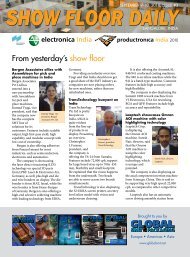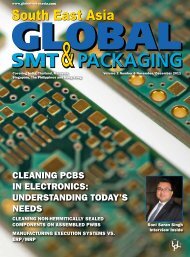South East Asia - WordPress.com - BluOcean.AdMedia
South East Asia - WordPress.com - BluOcean.AdMedia
South East Asia - WordPress.com - BluOcean.AdMedia
Create successful ePaper yourself
Turn your PDF publications into a flip-book with our unique Google optimized e-Paper software.
Figure 2. LED BIN code included in 1D or 2D barcode on supplier label.<br />
different BINs on the assembly floor.<br />
Fortunately there are industry<br />
standards, such as NEMA SSL 3-2010, that<br />
establish bin structures while promoting<br />
continuity amongst suppliers 2 . This helps<br />
the PCB assembler in that they can at least<br />
identify the BIN associated with each reel.<br />
On a reel of SMT LEDs, the BIN code is<br />
typically included within a barcode or 2D<br />
matrix on the supplier label, to facilitate<br />
data acquisition by a material tracking<br />
system (Figure 2).<br />
automotive oeM requirements<br />
To meet automotive OEM traceability and<br />
quality specifications, Methode sought a<br />
higher level of SMT line setup validation<br />
than traditionally available. Instead of<br />
simple validation based on <strong>com</strong>ponent<br />
PN only, Methode specified the additional<br />
requirement to validate based on the<br />
LED BIN, to ensure that only <strong>com</strong>patible<br />
BINs are placed onto any given PCB in<br />
accordance with design specifications.<br />
Traditional validation solutions <strong>com</strong>pare<br />
the actual line setup to a static recipe<br />
(i.e. the PNs and assigned feeder slots in<br />
the placement machine program). The<br />
additional requirement to validate based<br />
on BIN introduces a new requirement;<br />
dynamic setup validation. Why dynamic?<br />
Because the correct BIN to load into the<br />
machine at any given time may depend<br />
on the other BINs presently loaded<br />
on the machine, or whether there are<br />
partially populated PCBs in the placement<br />
machine during reel replenishment. The<br />
required solution would also include<br />
control systems for physically preventing<br />
the machine from placing <strong>com</strong>ponents<br />
whenever the risk of a BIN mismatch or<br />
<strong>com</strong>ponent PN error is present.<br />
Methode’s customer also demanded<br />
Traceability for every <strong>com</strong>ponent Lot<br />
Number (LN) for each serialized PCB.<br />
Again, traditional methods would fall<br />
short of expectations. To provide proof<br />
of <strong>com</strong>pliance to the customer’s design<br />
specifications, Methode specified that the<br />
traceability data must also include the BIN<br />
code for every LED placed onto each PCB.<br />
www.globalsmtindia.in<br />
Their customer’s traceability specifications<br />
also require data storage and accessibility<br />
over a 15 year period.<br />
An additional goal was to eliminate<br />
variability between individual product<br />
units. Ac<strong>com</strong>plishing this would require a<br />
traceability system that could integrate with<br />
their functional test equipment to enable<br />
automatic product tuning and calibration.<br />
After a thorough analysis of potential<br />
suppliers, Methode Electronics partnered<br />
with a leading supplier of track-tracecontrol<br />
(TTC) solutions for the electronics<br />
manufacturing industry. The partner<br />
delivered TTC software modules for line<br />
setup validation (Figure 3) and lot code<br />
traceability that account for the LED BIN<br />
codes used during SMT assembly.<br />
ensuring data integrity<br />
“Garbage In, Garbage Out” is a catch<br />
phrase that definitely applies to TTC<br />
systems. Methode understood it would<br />
be pointless to implement TTC SW<br />
without checks and balances to ensure<br />
100% data capture and accuracy 3 . For this<br />
reason, sources of data loss and error were<br />
eliminated wherever possible.<br />
Figure 3. Line setup validation SW accounts for LED BIN as well as PN.<br />
LED BIN validation & traceability<br />
When tracking serialized products,<br />
a <strong>com</strong>mon source of data loss <strong>com</strong>es<br />
from the need to capture each PCB serial<br />
number at scan points along the assembly<br />
line. In such applications, the PCB S/N is<br />
typically denoted by a barcode or 2D data<br />
matrix symbol. The PCB S/N can easily<br />
be missed due to quality issues associated<br />
with the creation and placement of the<br />
S/N identifier, or if scanners along the line<br />
are not properly adjusted during product<br />
changeover. The risk of data loss is greater<br />
in higher mix environments with frequent<br />
product changeovers and a wide variety of<br />
PCB form factors.<br />
Product flow controllers (PFCs) were<br />
implemented to control the SMEMA<br />
handshake between conveyors and<br />
placement equipment. The PFC only<br />
allows product transfer when the TTC SW<br />
confirms a successful scan of the product<br />
serial number (Figure 4). Thus, Methode<br />
can assure their customer a 100% read rate<br />
of PCB S/N. The PFCs are also used to<br />
prevent product transfer when the TTC<br />
system detects a downstream line set-up<br />
discrepancy, or potential BIN mismatch,<br />
thereby preventing defects.<br />
Another typical error stems from<br />
mistakes made by production operators<br />
when manually associating feeders<br />
with feeder locations on the placement<br />
machine. To poke yoke the setup and<br />
replenishment processes, Methode<br />
deployed RFID technology to convert their<br />
placement equipment into the smart feeder<br />
variety. A low cost RFID tag was attached<br />
to each feeder and an RF antenna array<br />
was installed on each feeder bank,<br />
Global SMT & Packaging <strong>South</strong>east <strong>Asia</strong> – Winter 2010 – 21









